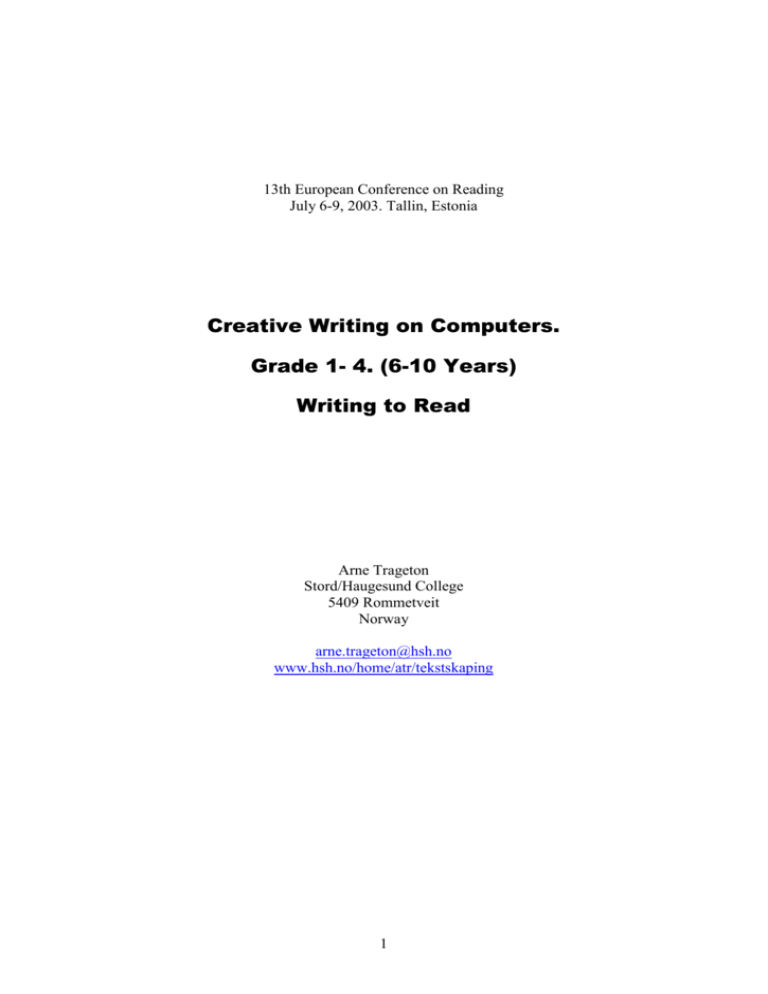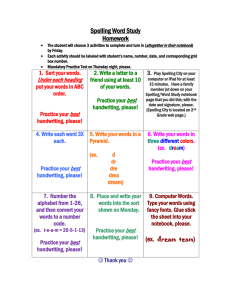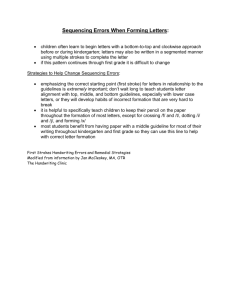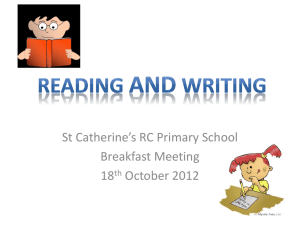Creative writing. 13th conference of Reading
advertisement

13th European Conference on Reading July 6-9, 2003. Tallin, Estonia Creative Writing on Computers. Grade 1- 4. (6-10 Years) Writing to Read Arne Trageton Stord/Haugesund College 5409 Rommetveit Norway arne.trageton@hsh.no www.hsh.no/home/atr/tekstskaping 1 Background The Norwegian National Curriculum (L97) demand digital literacy and writing on PC, but up to know computers in schools have been misused in an consumer ideology based on behaviourism (Erstad 1998, Healy 1999). The child as producer and communicator of knowledge reflect L97, a constructivist and social - interactionist view on learning (Piaget/Vygotsky, Lave 1991, Ludvigsen 1999). The project was a 3-year action research project in 14 classes in Norway, Denmark, Finland and Estonia. The Norwegian classes dominate the presentation. The children are followed from grade 1 to 4. All schools had 2-10 recycled, cheap computers placed in corners in the classroom, only equipped with a simple word processing program. Research problems: 1. How to use word processors in creative writing for grade 1. - 4. ? 2. How to build a digital database of the children´ text production over 3 years? 3. How to build networks between schools and communities for spread of the innovations? 4. Will concentration around computer writing in grade 1 and 2, delaying the formal teaching in handwriting to grade 3 give better results in written language? Qualitative development Grade 1. (Trageton 2001) Through 1500 texts from Grade 1 (6 year olds), we mapped the development of spontaneous computer writing for the first time in the Nordic countries. The development was rather similar to the better-established research in spontaneous handwriting development (Sulzby 1982-1990), but goes faster, because some steps in handwriting do not exist, and computer writing is easier. The results are similar to Schrader´s (1990) in USA. Through playful writing the children learned 24 capital letters and 20 minor letters as mean score. The children also wrote small texts and stories. Karlsdottir (1998) concludes that letter knowledge by 7 year age was the most important factor to predict reading ability in grade 4. Grade 2 (Trageton 2002) The children knew most of the letters and had written themselves to read in grade 1. The formal teaching of letters and reading by ABC books traditionally used in grade 2 in Norway became unneccesary. The children simply continued to write and read. The playful writing/reading (Liang & Johnson1999) exploded in the beginning of the school year. The 2 children, working in pair, became assistant “teachers” fortheir comrade, discussing technical problems and content in the writings. Capital letters were now regarded as childish. They used minor letters as in “real books”. 2700 texts from grade 2 gave background for analysing development in grade 2. Newspaper production, reading books and letters were the most important genres in grade 2. Playing “newspaper office” with editor, journalists and lay out people became an inspiring challenge. The printed letters gave professional layout. One newspaper had 12 pages, with national and local disasters, sports, jokes, school activities, working for a child centre for homeless children in Brazil, and comic stripes. In playing “publishing house” production of ABC-books became popular. They made easy readers of different levels, suitable for different reading levels. The authors wrote books about different themes, from classical fairy tales to modern science fiction. One class produced 100 textbooks in two months. Rich class libraries became important. Grade 3 (Trageton 2003) The children continued in central genres at a more advanced level, divided in more subgenres. In newspaper productions the standards are raised. The classes studied different professional newspapers thoroughly, and had serious discussions about the choice of content, picture placement and size, titles, ingresses and plain texts. The total newspapers might be 20 pages, richly illustrated of good drawings. Rich variation of content, objective handling of complicated, controversial national and international matters showed high journalistic level. Book productions became more varied and serious within factual prose and fiction, many subgroups and creative blending of genres. The boys were inspired of action, films, comics, horror books, while the girls loved fairy tales and romantic literature. Dramatizing script ideas and drawing the story before or during writing heightened the quality. Long lasting cross-disciplinary themes were stimulating for joyful writing. An example: A 2-month theme “To Fly”, included science, social science and mathematics, assisted by art and craft. The writings varied from Greek mythology to birds to modern airports. The process orientated strategy (Hoel 2000) raised the quality. Here computer writings have their greatest advantages. The first draft got constructive response from the computer-fellow and the teacher. The child might produce 1. version -> response -> 2. version -> response up to the 10. version of books of 20-60 pages without problems. In handwriting this would be impossible. Oral response is still dominating, but written response gave now good results. The 3 8 year olds read longer and more complicated books, often several hundred pages. They make reports and book reviews of professional authors and the books of their comrades. Denmark, Finland, Estonia These classes show similar development. But while the Norwegian 6 year olds continue in the same institution, the children in other countries changed institution from preschool for the 6 year olds to school for the 7 year olds. The children shifted both institutions and teachers, and discontinuity became a problem. The Danish grade 1 (7 year olds) started first in the middle of the year because of the late installations of computers in the classroom and new teachers. The writing level was lower than the Norwegian classes. But in grade 2 (similar to grade 3 in Norway) the children show a similar level as Norwegian classes. The teachers felt that computer writing made it easier for the multicultural children to learn Danish as a foreign language. The Finnish class had Swedish as their mother tongue. Their writing level was high, and their reading skills imposing. The children changed physical environment from “preschool/kindergarten” for the 6 year olds to primary school, grade 1 when they became 7 year olds, like in Denmark. But the preschool teacher was allowed to follow up the children in grade 1 and 2. In Estonia the project became a kindergarten project for the oldest children in the 3-7 year olds group. We could not follow the same children for 3 years, like the other countries. The level of writing was amazing high. For example one 6 year old started making a book about a bull and a cow. The preschool teacher expected the book to be 10 pages before ready! In the end of the project a classroom teacher tried to follow up the work in grade 1. (Lang 2003). Her class was divided in 5 groups working in the classroom with the 6th group in the library writing on four computers. A special computer teacher assisted them. Quantative evaluation of writing level The qualitative development description are based on 7500 texts, 60 edited videos, direct observations and teacher reports (Trageton 2003b) Hypothesis 4 on page 1 was: Will concentration around computer writing in grade 1 and 2, delaying the formal teaching in handwriting to grade 3 give better results in written language? International reading tests (IEA) are regarded relative valid and reliable, but writing tests are controversial. The IEA writing test for grade 6-9 resulted in cultural disagreement of what 4 was a ”better” written composition (Purvis 1992, Allard 1991). In England “The implementation of the National literacy strategy” (DEE 1997) gives some guidelines for writing for Keystage 1 (9 years). USA has a long tradition of evaluating the quality of children’s texts (Gorman et al 1988). Evaluation of the American computer-writing project WTR, used different scales for 6-7 year olds (Chamless & Chamless 1993). Different states of USA present norms for “good” writing. “Pennsylvania State Curriculum in Writing” developed detailed guidelines from Kindergarten to grade 6. A specification for grade 3: 1. Composes pieces that develop a problem or central idea and flow from beginning, middle to end 2. Adapts writing style/form to maintain focus on topic, purpose and/or audience (stories, letters, journals, poems, plays) 3. Includes literacy elements in narratives (characters, setting, problem, major events, solution) 4. Write complete sentences (subject + verb) using end punctuation appropriately (periods, exclamation points, question marks) most of the time In Norway there was strong resistance in using a predefined set of norms. We used a holistic evaluation based on connoisseurship (Eisner 1996). Quality in creative writing. End Grade 3. 8 ”PC classes” and 9 ”handwriting classes” got two 40 minutes writing tasks: “Make a fairy tale” and “A visit to the dentist”. The handwritings were transcribed to computer text and mixed randomly with the responses from PC classes. Two experienced teachers in teacher education scored the content quality of 594 texts from 1-4, where the highest score is 4. The agreement between evaluators was high. Results: Dentist visit Fairy tale Boys Girls Total Boys Girls Total PC classes 2.16 2.54 2.33 2.27 2.43 2.32 Hand-writing classes 1.78 2.28 2.05 1.85 2.24 2.05 The results show clearly higher scores for the PC classes in both writing tasks by boys and girls, highest difference for the boys (jf. Keetly 1997). All differences are significant at p<0.001level. The boys` scores are lower than girls, but in 4 classes the mean score was alike. 5 Reservations: 1. The comparing classes are statistically a stratefied sample. 2. An experiment always tend to get better results (Hawthorne effect) Handwriting test The most controversial in the project was delaying the formal teaching of handwriting to grade 3. Would this delay be negative for handwriting? A test compared the quality of the handwriting between “PC classes” and traditional “Handwriting classes” Two experienced specialists on handwriting in primary school, made a holistic assessment of the quality of the handwriting on a scale 1 – 4, where 4 is best. The agreement between evaluators was high. Results. Quality of handwriting PC classes: 2.74 Handwriting classes 2.45 How many words written in a minute? PC classes 4.35 Handwriting classes 4.91 In spite of delayed formal teaching and much shorter training time in handwriting, the PC classes showed better quality of the handwriting, but a little slower speed. The differences are significant at p<0.001 level. The delay was most profitable for boys. Conclusion Developing new methods for literacy learning in lower Primary school are the main results. (Trageton 2003 b). 3 years experience documented with 7500 texts and 60 edited videos shows the development. READING-and writing teaching was revolved 180 degrees to WRITING- and reading learning. Writing is easier than reading. (Clay 1975, Chomsky 1982, Sulzby 1982-1990, Hagtvet 1988). Using the computer as the writing tool instead of the complicated handwriting made this “revolution” possible. The letters in writing/reading became identical, and the correspondence writing/reading easier. The results are in tune with the huge American project “Writing to Read” (Chamless & Chamless 1993). However, their equipment and strategy was too complicated and costly (Singh 1993), compared with the recycled computers used in the Nordic project. Høyen (1996) stress decoding as the central factor in reading: Reading = decoding x understanding When the child is writing to read however, he start with the easier coding of own thoughts: 6 Understanding x coding x decoding = reading of meaningful text When the child is writing/reading a meaningful text grown out of his own imagination, he will in addition develop letter knowledge, use combinations of the phonic method, word method and understanding the total text is a meaningful whole language. This is the theoretical explanations why “Writing to Read” seems more effective than starting reading foreign texts from an ABC primer (Willows 1988). The task becomes more motivating for the child. Future research Many communities in Norway started new projects 2002-2005 to replicate and improve this literacy strategy for grade 1-4. My preliminary results will then be re-evaluated of master students in “ICT and learning” on a larger scale (Vavik 2003, Salomon 2003). Many countries show interest in similar strategy. Reading tests dominate the international debate. Our Ministry for Education have funded development of writing tests for grade 4, 7 and 10 (Berge et al 2003). This may become the start of a new “ Centre for WRITING research” parallel to the existing “Centre for READING research”. Should “Reading Associations” change to “Literacy Association”? www.hsh.no/home/atr/tekstskaping References Allard B & Sundblad B (1991) Skrivandets genes under skoltiden. Ped. institutionen. Stockholm universitet Berge K L et al (2003) Utvikling og utprøving av nasjonale prøver i skriving. Prosjektbeskrivelse. Universitetet i Oslo Chamless J & M Chamless (1993) The effects of instructional technology on academic achievement of 2 nd grade students. University of Mississippi Chomsky C (1982) Write now, read later. I Cazden (red) Language in early childhood education.Wash. NAEYC DEE (1997) “The implementation of the national literacy strategy” London Eisner E (1996) Cognition and curriculum reconsidered 2. ed. Chapman. London Erstad O (1998)Innovasjon eller tradisjon. ITU. Universitetet i Oslo Gorman T P, Purves A C, Degenhart R E (1988) IEA Volum 5. Pergamon Press. N.Y. Healy J M (1999) Failure to connect. How computers affect our children`s minds – for better and worse. Simon & Schuster. N.Y Hoel T Løkensgard (2000) Skrive og samtale. Responsgrupper som læringsfellesskap. Gyldendal Akademisk Høien T (1996) Avkodingsstrategier og leseutvikling. I Austad (red) Mening i tekst. LNU/Cappelen Akademisk Karlsdottir R (1998) Utvikling av lese- og rettskrivingsgferdigheter hos grunnskolebarn i Trondheimsområdet. I Learning strategies and skill learning. Skrift 4 s 93-109. Det kgl. norske videnskabers selskab. Tapir. Trondheim 7 Keetley E (1997) Comparison of first grade computer assisted and handwritten process story writing. Dissertation Johnsen and Wales Univeristy. USA Liang & Johnson (1999) Using Technology to Enchance Early Literay Through Play. I Blanchard: Educational Computing in the Schools pp 55-64 L 97 Læreplanverket for den 10 -årige grunnskolen (The National Curriculum 1997) KUF Lave/Wenger (1991) Situated learning- Legitimate peripheral participation. Cambridge University. N.Y. Ludvigsen S (1999) Informasjons- og kommunikasjonsteknologi, læring og klasserommet. Bedre skole nr 2 Purves A C (1992) The IEA Study of Written Composition II: Education and Performance in Fourteen Countries. Pergamon Press: Oxford Salomon G et al (2003) Computers and writing. In T. Nunes & Bryant P (eds). Handbook of children`s literacy pp 409-442. Kluwer. London Schrader ( 1990)The Word Processor as a Tool for developing Young Writers. ERIC ED 321 276 Singh B (1993) IBM`s Writing to Read program: The right stuff or Just High Tech Bluff? ERIC ED 339 015 Sulzby E(1990) Assessment of emergent writing and children`s language while writing In Morrow/Smith (eds) Assessment for instruction in early literacy. Englewood Cliffs. The State college area school district (2000) A curriculum guide for parents 2001-2002. State College. Pennsylvania Trageton A (2001) Creative writing on computers. Playful learning. Grade 1 ICCP. Erfurt. Germany Trageton A (2002) Creative writing on computers. Playful learning. Grade 2 TASP Santa Fe. New Mexico Trageton A (2003) Creative writing on computers. Grade 3. End results NFPF. Copenhagen Trageton A (2003 b) Å skrive seg til lesing. IKT i småskolen. Universitetsforlaget Vavik L (2000) Facilitating learning with computer-based modeling and simulation environments. Doctoral dissertation. University of Bergen Vavik L (2003) Writing to read with ICT support. Research description. Stord/Haugesund University College Willows D M (1988) Writing to read as a new approach to beginning language arts instruction Ontario Institute for Studies in Education. Toronto 8








